How To Make Paint Glaze With Water
As acrylic painters we thin our paints with water to lower viscosity and make thin washes. Many of us also use mediums to alter consistency and viscosity and brand translucent glazes. Merely, it is not e'er obvious how and when to use these mixtures, or how versatile they tin be. Acrylics' natural versatility allows for a wide range of uses for both, and this article seeks to describe the differences, similarities, characteristics and attributes of washes and glazes, and when one might be better or more useful than the other.
The master similarity between washes and glazes is the translucent color furnishings possible with both, which allows the undertone of the colour to show itself. Typically, washes soak into a surface, while glazes sit down on top. Most of the washes and glazes shown here were made with about 1 part pigment to well-nigh xc parts water or medium, but there is a wide range of ratios possible.
What are Acrylic Washes?
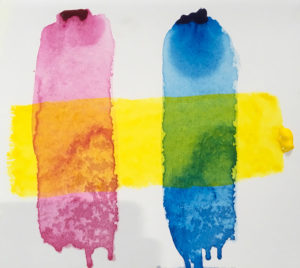
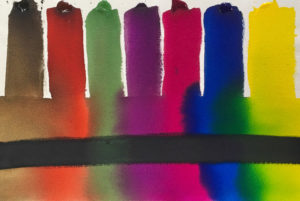
An acrylic wash is fabricated by thinning pigment with a lot of h2o. Thinning reduces both the amount of acrylic and pigment in the mixture. When a wash dries you end up with widely dispersed paint particles settled down into and on the painting surface, with a very small amount of acrylic binder. With washes, pigment particles tin can meander and collect in concentrated areas depending on how information technology is practical and how absorptive or non-absorbent the substrate is. These flowing, child-bearing and sometimes hard to control effects, tin can be both challenging and heady to piece of work with. While you lot can sparse our Heavy Body Acrylics with water to make washes, it is easier to apply our Fluid Acrylics or Loftier Menstruation Acrylics for this.
We have seen very thinned out Fluid or Heavy Body Acrylics of ours function very well in terms of film stability and water sensitivity. One tin be fairly free with the amount of water used. If there is a concern well-nigh the wash being too weak a film, then a pocket-sized amount of sparse medium such as High Catamenia Medium or Fluid Matte Medium can exist added. Or, a thin layer of a Medium can be used on acme of the dry out wash to create a more durable surface. More than details near how much water can exist used to thin our acrylics tin can be constitute in this commodity:
How Much Water Can you Safely Add to Acrylic Paint?: https://justpaint.org/how-much-water-tin-yous-safely-add together-to-acrylic-paint/
What are Acrylic Glazes?
An acrylic glaze is made by extending paint with whatever transparent or translucent Medium. A glaze is a binder rich mixture typically having a very minor amount of pigment blended with a much larger amount of medium. Many mediums tin exist used to create a glaze, including thinner mediums like High Flow Medium or Glazing Liquid all the way up to very thick Gel Mediums. Opaque mediums like Molding Pastes or Pumice Gels will non work well to mix effective glazes. While traditionally glazes were thought of as thin films, acrylic glazes take much broader potential and can be sparse or thick, and everything in between. Y'all can freely alloy either our Heavy Torso or Fluid Acrylics or fifty-fifty our High Flow Acrylics with any Golden transparent or translucent medium or gel medium to create glazes.
Glossy mediums dry with the greatest clarity or translucency, while semi-gloss or matte mediums will dry translucent and with some level of cloudiness due to the matting agents present. When used to brand glazes, these lower sheen mediums tin yield some very cute furnishings that take advantage of their foggy and misty qualities. For additional data, here are articles on encaustic effects with acrylic, and glazing with acrylics, oils and watercolors:
Encaustic Effects with GOLDEN Acrylics: http://www.goldenpaints.com/videos/encaustic-effects-with-golden-acrylics
Encaustic Look with Acrylics: https://justpaint.org/creating-an-encaustic-expect-with-acrylics/
And this commodity as well shines some lite on the topic: Glazing with Acrylics, Oils and Watercolors: https://justpaint.org/glazing-with-acrylics-oils-and-watercolors/
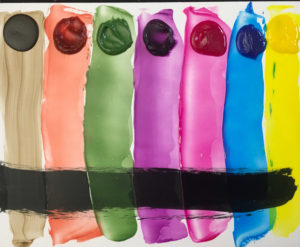
When to Wash or Glaze?
Acrylic washes work well when you want thin pigment to blot into the surface like a stain, and to create effects reminiscent of watercolor. Raw canvas, primed canvas, an absorptive basis, or paper are all suitable options for substrates where washes can create a stained effect. Washes can exist used on dry or pre-moistened absorptive surfaces. In some cases, washes tin exist used on less absorbent surfaces. Gilded Wetting Amanuensis can be added to the wash mixture or also mixed into water and used to pre-wet an absorbent surface, which can allow for deeper staining effects. Only very small amounts are necessary and Wetting Agent is optional. Oftentimes, the acrylic paint itself will include enough surfactant. Hither is more information:
Wetting Amanuensis: http://www.goldenpaints.com/technicalinfo_flreleas
Acrylic Wash and Stain Painting on Raw Canvas: https://www.youtube.com/watch?v=dHPybGEYshs
GOLDEN High Menstruum with Acrylic Flow Release (Wetting Agent) for staining on canvass: http://www.youtube.com/lookout man?v=qn0him0FiSg&list=UU7Q21sJbaAVOIylhu3E7row

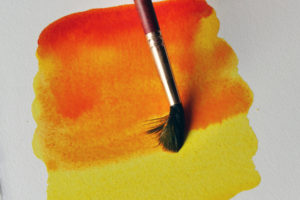
Glazes are useful when y'all desire a translucent color upshot in a unimposing paint picture show assuasive more than control over the dry surface sheen, and how the paint can be handled on the surface. The viscosity of a glaze combined with the pigment held in even intermission allows for both sheer and graduated color effects, and also sharper controlled edges, depending on how you manipulate the glaze. Some of the most intense color effects can be created with glazes, especially when using certain synthetic organic colors like Quinacridones or Phthalo Blues and Greens. Glazes with these colors used over white grounds will show the very high chroma undertones and tin create brighter colors than tinting with white or using full strength colors opaquely.
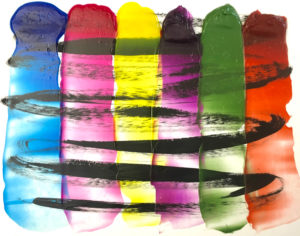
Glazes can exist used on less absorbent or more absorbent surfaces. They can be thin or quite thick, applied with brushes or spreading tools such as palette knives or squeegees. They can even be poured if you use a thin medium, keeping in mind that some sparse mediums will tend to craze if applied too thickly. A brushed on coat can often dry with very visible brush marks due to the darker drying of the raised areas within the brush marking. If this is not desired, use a thinner medium to brand the glaze and use with a palette knife or other spreading tool, or a soft, apartment synthetic bristle brush.
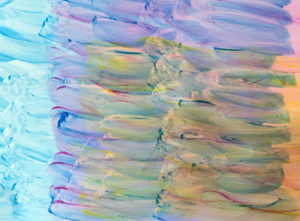
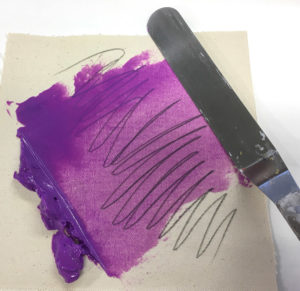
How Do I Make and Utilize Washes and Glazes ?
There are no rules for ratios with either water for thinning, or medium for extending, as it all depends on the level of translucency, color intensity, specific consistency and dry surface sheen. While thinning acrylic paint with water to make washes is pretty uncomplicated and direct, mixing glazes can be a bit more complex, both in the options available and in how they can be used and function in a painting. Experimentation, as always, will be the best way to larn how to use these mixtures. The natural versatility of acrylic paints and mediums allows for a wide range of uses. Every bit mentioned at the start, virtually of the washes and glazes shown here were fabricated with approximate 1/ninety ratios of paint to h2o or medium, but the possibilities are really infinite.
Acrylic washes or glazes can be used on raw or gessoed canvas or on a range of other acrylic painting grounds. Acrylic washes tin can be layered much like watercolor and glazes tin also be layered with a broader range of effects possible due to surface texture variations, a more discreet separation of the layers and the fashion light filters through translucent acrylic films. Optical color mixing is possible with both washes and glazes, and there is typically no limit to the number of layers you tin use, other than diminishing color at a certain point.

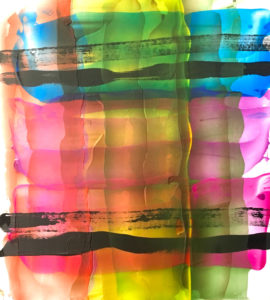
Sometimes it is best to pre-mix larger amounts of a wash or a coat and store in plastic containers with lids, so that you have plenty of the mixture to employ for a painting or a series of paintings. A swatch of the glaze or castor out of the wash on the lid works well every bit a label and will remind you of the inevitable dry color change that occurs with glazes. You lot may demand to first apply some Absorptive Ground on the lid to bear witness a wash or simply attach a piece of paper or raw canvas to the chapeau.
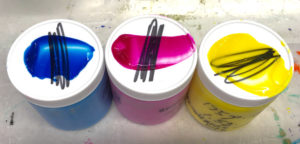
Washes are typically applied by castor but can also be applied with sponges or by dripping, pouring or splattering. Glazes can be applied with brushes when they are thin and every bit they get thicker, spreading tools of various sorts tin can create lovely, sheer and consistent veils of color. Experiment with palette knives, scrapers and squeegees.
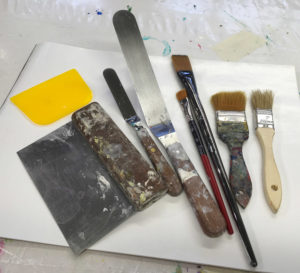
Some very interesting and beautiful effects are possible by combining and layering washes and glazes. You tin can work wet into moisture with glazes on top of washes, or thin glazes with h2o to create something in-between a wash and a coat. Very translucent glazes tin be layered with more opaque painted marks to create very rich and circuitous surfaces and visual effects. Below are some details of paintings using various combinations of washes and glazes.
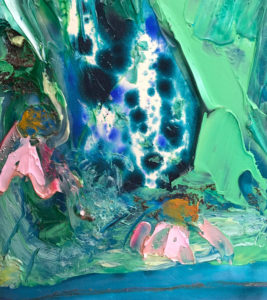
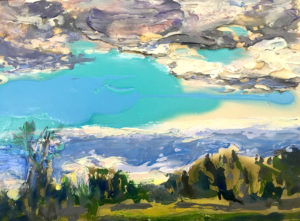
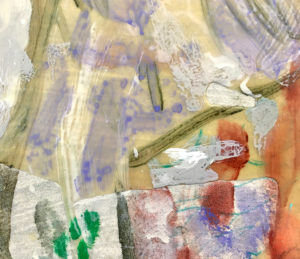
How To Make Paint Glaze With Water,
Source: https://justpaint.org/washes-and-glazes-what-when-and-how/
Posted by: wayswee1997.blogspot.com



0 Response to "How To Make Paint Glaze With Water"
Post a Comment